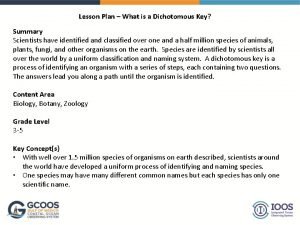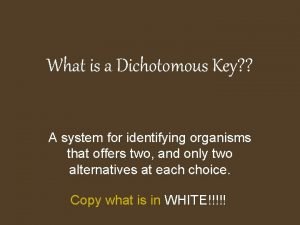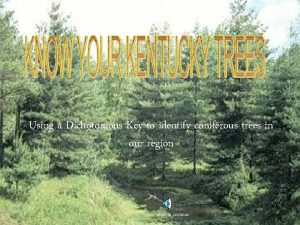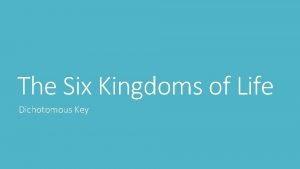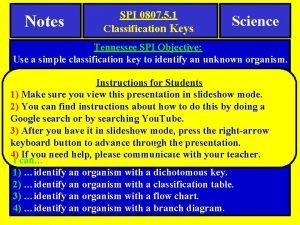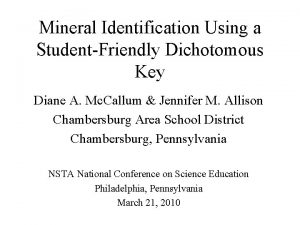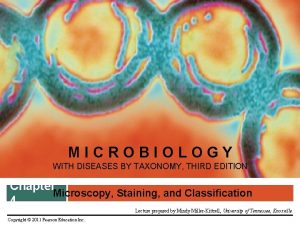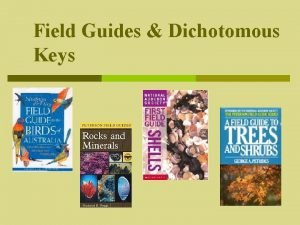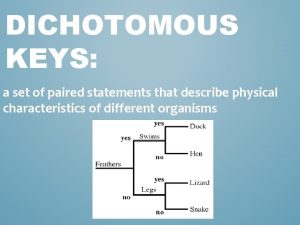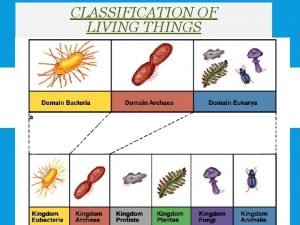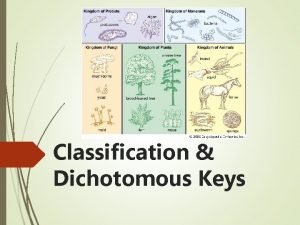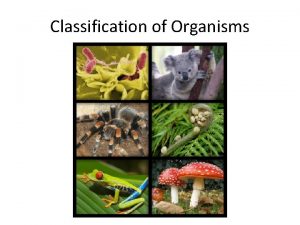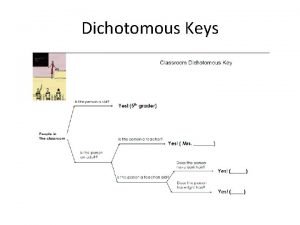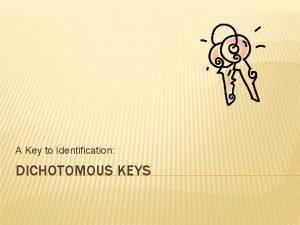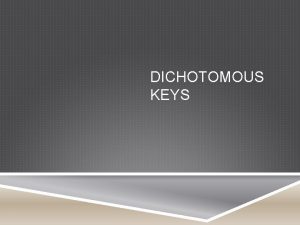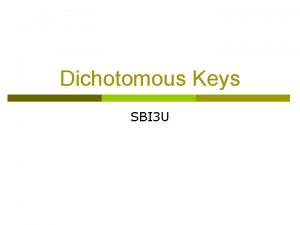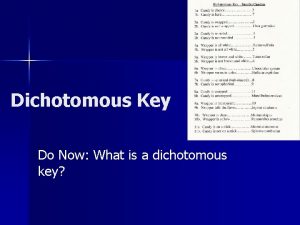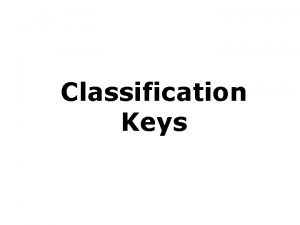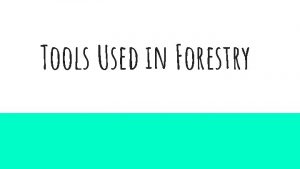Lesson Plan What is a Dichotomous Key Summary

















- Slides: 17

Lesson Plan – What is a Dichotomous Key? Summary Scientists have identified and classified over one and a half million species of animals, plants, fungi, and other organisms on the earth. Species are identified by scientists all over the world by a uniform classification and naming system. A dichotomous key is a process of identifying an organism with a series of steps, each containing two questions. The answers lead you along a path until the organism is identified. Content Area Biology, Botany, Zoology Grade Level 3 -5 Key Concept(s) • With well over 1. 5 million species of organisms on earth described, scientists around the world have developed a uniform process of identifying and naming species. • One species may have many different common names but each species has only one scientific name.

Lesson Plan – What is a Dichotomous Key? Key Concept(s) • Binomial nomenclature gives each described named species a two part name; the genus and species. • A dichotomous key is a guide in which you progress through steps, each with two questions, until you identify an organism. Objectives Students will be able to: • Describe the difference between a common name and a scientific name. • Understand that scientist sort living things into groups for classification from large Kingdoms down to individual species. • Explain and demonstrate how to use a dichotomous key.

Lesson Plan – What is a Dichotomous Key? National Science Education Standard or Ocean Literacy Essential Principle Learning Goals Unifying Concepts and Processes 1. Systems, order, and organization Types and levels of organization provide useful ways of thinking about the world. Types of organization include the periodic table of elements and the classification of organisms. Life Science C. 1. Characteristics of organisms Each plant or animal has different structures that serve different functions in growth, survival, and reproduction. For example, humans have distinct body structures for walking, holding, seeing, and talking. Principle 5 (3 -5, B. ) The ocean provides most of Earth’s living space and supports a great The ocean supports a great diversity of life from the surface, through the water column, and ecosystems. down to the sea floor. Diversity of Life


People have many names for the same thing. What would you call it?

People have many names For the same things. What would you call it? Car Truck Transportation Automobile Motor Vehicle Bucket of Bolts Pick-up truck 2015 Toyota Tacoma pick-up truck Four-door 2015 Toyota Tacoma pick-up truck

Scientists Need to Speak the Same Language! • Confusion over words may not seem like a big deal, but it can be! We are sinking! What are you thinking about? German Coast Guard

Nomenclature: How scientists name living things by sorting into groups. • • Kingdom Phylum Class Order Family Genus Species LEAST Similar MOST Similar

Carl Linnaeus, 1758 Created the system of naming living things. Binominal nomenclature Ursus arctos, Linnaeus, 1758 Ursus maritimus, Phipps, 1774

YES or NO: The key to naming living things is asking the right questions! • Dichotomous (dīˈkätəməs) means divided in two parts. • When you use a dichotomous key, you follow a path. Each choice along the path has only two questions. The answer is always YES or NO. 1. Does it have a shell? YES, go to question 2 NO, go to question 3 2. Does it have two shell halves that fit together? 3. Does it have wings? YES, it is a butterfly NO, go to question 4 4. Does it have 8 legs? YES, it is a spider YES, it is a clam

Let’s Practice! We will divide into groups. I have five bags with supplies. How many can be in each group? Groups: 3 groups of 4 2 groups of 3

Let’s Practice! 1. Is it an animal Yes, go to 2 No, go to 7 2. Does it have feathers Yes, it’s a bird No, go to 3 3. Does it have fins Yes, go to 4 No, go to 6 4. Does it have gills Yes, it’s a fish No, go to 5 5. Does it have a blowhole Yes, it’s a whale 6. Does it have a long trunk Yes, it’s an elephant 7. Does it have leaves Yes, it’s a plant

Test your ‘Yes’ and ‘No’ Questioning Skills! • Asking the right questions is key to figuring out what things are. • We are going to play a game. • You will have the picture of a living thing taped to your back. YOU cannot look at it. Your classmates can. • You can ask them questions about what it is, BUT you can only ask Yes or No questions.

Let’s Practice First! • • • Does it live in the water? Does it live on land? Can it fly? Does it have fur? Is it a mammal? Is it wild? Can it be a pet? Is it a dog? Is it a cat?

Make Your Own Dichotomous Key • Work in groups of two or more people. • Each team take a paper bag. • Choose at least five items from your bag. You can use all of the items if you are feeling inspired! • Using “yes” or “no” questions, make a key that leads to the identification of each of the items you selected. • Use the practice sheet from before as a guide. There also real identification keys to view if you need ideas.

1. Is it an animal Yes, go to 2 No, go to 7 2. Does it have feathers 3. Does it have fins Yes, it’s a bird No, go to 3 Yes, go to 4 No, go to 6 Yes, it’s a fish No, go to 5 Yes, it’s a whale 5. Does it have a blowhole 6. Does it have a long trunk Yes, it’s an elephant 7. Does it have leaves Yes, it’s a plant 4. Does it have gills 1. Is it an animal Yes, go to 2 No, go to 7 Yes, it’s a bird 2. Does it have feathers No, go to 3 3. Does it have fins Yes, go to 4 No, go to 6 Yes, it’s a fish No, go to 5 5. Does it have a blowhole Yes, it’s a whale 6. Does it have a long trunk Yes, it’s an elephant 7. Does it have leaves Yes, it’s a plant 4. Does it have gills 1. Is it an animal Yes, go to 2 No, go to 7 2. Does it have feathers Yes, it’s a bird No, go to 3 Yes, go to 4 No, go to 6 4. Does it have gills Yes, it’s a fish No, go to 5 3. Does it have fins 5. Does it have a blowhole Yes, it’s a whale 6. Does it have a long trunk Yes, it’s an elephant 7. Does it have leaves Yes, it’s a plant 1. Is it an animal 2. Does it have feathers 3. Does it have fins Yes, go to 2 No, go to 7 Yes, it’s a bird No, go to 3 Yes, go to 4 No, go to 6 Yes, it’s a fish No, go to 5 5. Does it have a blowhole Yes, it’s a whale 6. Does it have a long trunk Yes, it’s an elephant 7. Does it have leaves Yes, it’s a plant 4. Does it have gills

Acknowledgements Lesson developed by Dr. Chris Simoniello for Bay Point Elementary. Standards-cross-referencing and formatting by Grant Craig. Questions, comments, edits? Contact Dr. Chris: chris. Simoniello@gcoos. org
 Dichotomous key lesson plan
Dichotomous key lesson plan Fish dichotomous key answers
Fish dichotomous key answers Micro lesson plan format
Micro lesson plan format Rules of dichotomous key
Rules of dichotomous key Dichotomous key to the conifers answers
Dichotomous key to the conifers answers Dichotomous key for the 6 kingdoms
Dichotomous key for the 6 kingdoms Dinosaur dichotomous key
Dinosaur dichotomous key Rock dichotomous key
Rock dichotomous key Identification keys in taxonomy
Identification keys in taxonomy Dichotomous key to representative birds
Dichotomous key to representative birds Creating a cladogram worksheet answer key
Creating a cladogram worksheet answer key An example of a parallel choice on a dichotomous key is .
An example of a parallel choice on a dichotomous key is . Hagfish cladogram
Hagfish cladogram Dichotomous key generator
Dichotomous key generator Pogil classification
Pogil classification Dichotomous key shark activity
Dichotomous key shark activity Phylogenetic classification ppt
Phylogenetic classification ppt Dichotomous classification
Dichotomous classification
